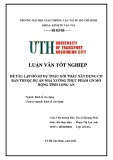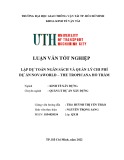MINISTRY OF MINISTRY OF AGRICULTURE
EDUCATION AND AND RURAL DEVELOPMENT
TRAINING
THUYLOI UNIVERSITY
PHAM QUANG DONG
RESEARCH ON THE VACUUM CONSOLIDATION METHOD
FOR SOFTSOIL IMPROVEMENT IN WORKS
CONSTRUCTION
Major : GEOTECHNICAL ENGINEERING
Code : 62-58-60-01
SUMMARY OF DOCTORAL DISSERTATION
HANOI – 2015
The thesis is completed at:
THUYLOI UNIVERSITY
Promotors: 1. PROF. DR. TRINH MINH THU
2. PROF. DR. NGUYEN CHIEN
Reviewer 1:
Reviewer 2:
Reviewer 3:
The thesis was defended successfully at the Doctoral graduation
committee at
ThuyLoi University – 175 Tay Son – Dong Da – Hanoi
at …..hour…..date…..moth…..year…..
The thesis could be found at: National Library Or Water Resources University Library - 175 Tay Son – Dong Da –
Hanoi
1
PREFACE 1. Background of the topic
The vacuum consolidation method has been applied successfully all over the world, and now it is chosen to improve the softsoil in Vietnam because this method has advantages as: shorten construction time, save loading materials, easily remove loading material after improvement, no environment pollution in construction, especially appropriate for ground improvement in a large and/or long area.
Vietnam has applied this method to improve the ground for some works, with technology and equipment managed by foreign partners. However, the knowledge and mastering of technology and equipment, and building of relationship among parameters of soft soil layer during vacuum consolidation process for soft soil in Vietnam are topical and essential. Therefore, the topic “Research on the vacuum consolidation method for soft soil improvement in works construction” has large scientific and practical significance. 2. Purposes of the topic - To define the variation pore water pressure and deformation (settlement) of soft soil layer during vacuum consolidation.
- To establish the relationship between Plasticity Index (PI), degree of consolidation (U), thickness of improved soft soil layer (H), and consolidation time (t) when improving the soft soil by vacuum consolidation method. 3. Object and Scope of research
- The softsoil in different projects at Dinh Vu – Hai Phong, Duyen Hai – Tra Vinh, Nhon Trach – Dong Nai, Thai Binh Thermal Power Plant – Thai Binh. - The softsoil in some another areas which have similar physical and
mechanical behaviors. 4. Contents of research
(1) Literature reviews the vacuum consolidation solutions for improving soft soil foundation all over the world and in Vietnam. Evaluate the existing problems in technics and point out the matters that the thesis is focusing on solving. (2) Apply the background theory to figure out parameters of vacuum consolidation process and compare with physical model test in laboratory and with the field treatment. (3) Study the installation and the operation procedures to be well controlled the vacuum consolidation technology. (4) Studying the variation pore water pressure and the deformation of soft soil layer in vacuum consolidation process by physical model. The study results are compared with calculated results from numerical model to see the conformity of digital
2
calculation model. (5) Determining the rationality of the numerical model to calculate and formulate the relationship between plastic index, consolidation, depth of softsoil improvement and consolidation time when apply the vacuum consolidation method. 5. Research Method
(1) Theory calculation and analysis method: research the vacuum consolidation problem, study the contents related to solving the vacuum consolidation problem. (2) Practical method: physical model experiment to determine the variation process of pore water pressure and deformation at interested locations and depths during the application of vacuum consolidation. (3) Statistics method: Processing the experimental and statistic data to establish and build the relationship between the parameters of vacuum consolidation process. (5) Expert method: organize workshops, scientific reports to collect comments from experts and scientists in the researched field. 6. Scientific and practical meanings
a) Scientific meaning There are few studies on factors that affect the vacuum consolidation process in Vietnam, therefore the results of this thesis on the variation pore water pressure and settlement in the softsoil of Vietnam can be used to predict the behaviors of softsoil when improving by vacuum consolidation.
Currently, there is no software applied for the vacuum consolidation problems, therefore, the selection of the appropriate finite element software has great scientific meaning.
To have basis for giving initial forecast on the consolidation process when improving the soft soil layer using vacuum consolidation method, the ability of building a relationship between consolidation parameters, consolidation time, plasticity index and the depth of soft soil layer for improvement is essential.
relationship when improving its
b) Practical meaning The research results will determine the variation law of soft soil layer, and the softsoil by vacuum establish consolidation, give a tool for geo-technician to give initial forecast on consolidation process when improving the softsoil by this method. 7. Contributions of the thesis
(1) Establish a large scale physical model which is the first model which applies the vacuum consolidation method to improve the soft coastal underlying soil has been performed at the Geotechnical Laboratory, ThuyLoi University to study the variation process of pore water pressure and the deformation of softsoil at different interested locations and depths.
3
(2) Select appropriate software to calculate the vacuum consolidation together with loading for the problem in the laboratory and at site. (3) Compute
index, degree of the relationship between plasticity consolidation, thickness of soil layer for improvement and consolidation time when improving the soft soil by the vacuum consolidation method. 8. Layout of the Thesis
Preface Chapter 1: Overview on the vacuum consolidation method for improving the softsoil and literature review Chapter 2: Experimental study on the vacuum consolidation method for softsoil improvement in the laboratory Chapter 3: Calculation model for vacuum consolidation problems Chapter 4: Establishment of a relationship between parameters of vacuum consolidation problems Conclusion and recommends List of publications References
Chapter 1 OVERVIEW OF VACUUM CONSOLIDATION METHOD FOR SOFTSOIL IMPROVEMENT AND THEORY OF THE METHOD 1.1. Softsoil
There have been many different definitions about softsoil, but it could be summarized that softsoil is the soil not suitable for works construction. The building in softsoil requires very careful improvement to ensure the structrures will be safe during the construction and operation time. 1.2. Overview of research and application of vacuum consolidation method 1.2.1. The application of vacuum consolidation method for improving softsoil in the world
(from France) applied
The vacuum consolidation method for improving softsoil was introduced for the first time in 1952 by W. Kjellman, in 1980, the vacuum consolidation was improved by a combination of loading and prefabricated vertical drain. In 1989, Menard Construction Company this improvement, since then, the method has been widely applied in many countries. Since 1997, Cofra Construction Company of Netherland had an improvement is to remove the protective membrane which made the construction difficult and vulnerable, however, a loading layer must be used to compensate the removed atmosphere pressure difference. Basically, the
4
vacuum construction method could be divided into 2 main types which are sealed air membrane and no sealed air membrane construction. 1.2.2. The situation of study on vacuum consolidation method There are many factors that will create effect on the vacuum consolidation method process, these factors have been researched by many authors from practical results in the lab and at site of actual works. The results of these researches also point out that depending on the type of soil, pressure level, type of prefabricated vertical drain, distance of prefabricated vertical drain affects the consolidation level of the ground. However, in addition to the above conditions which create the differences in research results; the horizontal consolidation coefficient and the disturbance level around the prefabricated vertical drain are major factors that affect the consolidation process and resulting in this difference. 1.2.3. The research and application of vacuum consolidation method for softsoil improvement in Vietnam
The application of vacuum consolidation for improving softsoil has been applied in some works in Vietnam. Based on the application result, this method proved itself as a new and an effective one. However, up to now, the design and construction using this method hold by foreign partners only. Therefore, it is essential to have research on the nature of consolidation process and understand the appropriate construction technology in the condition and actual situation to widely apply in the softsoil improvement in Vietnam.
There is not many research on vacuum consolidation method in Vietnam, and the researches are often based on the results of works improving at site. There is no practical model in the laboratory to study the variation parameter of pore water pressure and deformation variation of soil, as well as proper numerical model to check and compare. 1.3. Theory of vacuum consolidation method
1.3.1. Consolidation of softsoil The nature of consolidation is the decreasing of void ratio of soil due to the release of pore water by permeability process, as such, the soil particles transfer stress directly on each other, thus improve the connection of soil structure.
If the principles of mechanical compaction uses the loading to increase total stress, thus increase the effective stress. On the other hand, the vacuum consolidation will decrease the residual stress in pore, thus increase the effective stress without changing the total stress (fig 1.12).
5
Fig 1.12. Vacuum consolidation principles
1.3.2. Basic differential equation Terzaghi suggestted the basic differential equation of consolidation phenomenon as follows: (1-1)
According to N. Carrillo, the 3 dimensions consolidation problem will be written in this form: (1-2)
in which: Cv – vertical consolidation coefficient; Cr – radius-direction consolidation coefficient; u – residual pore water pressure.
1.3.3. Theory of consolidation To solve the consolidation problem with similar compression consolidation method and Barron – Terzaghi method, the scientists re-solved the problem of Barron – Terzaghi applying for the vacuum consolidation problem, in which there is solution of Wollongong University. Average value of pore water pressure at time t is determined by the formula 1-33:
(1-33)
The average consolidation and time can be determined by formula:
(1-35)
2;
In which: Cvh= Ch/Cv=kh/kv; L=l/de; l: Length of prefabricated drain; Th=Cht/de - coefficient of lateral expansion; pva – vacuum pressure.
6
1.4. Settlement prediction method
1.4.1. Asaoka method According to this method, the final settlement value will be predicted based on actual monitoring data. This data could modeled approximately as a straight line (Fig 1.20). (1-36) St+Δ = βSi+A In which:
β – slope of the most accurately stimulated regression line; A – extended intersection of line stimulating the vertical axis; After determining the stimulated regression line, the final settlement value in Asaoka is measured as:
(1-37)
Fig 1.20. Asaoka line
1.4.2. Inflection point method The inflection coefficients in theory and field are determined as the following equations:
(1-40)
(1-41)
The final settlement value will be measured based on the ration:
(1-42)
Conclusion of Chapter 1
The vacuum consolidation method has been studied and applied successfully worldwide and it has been partly applied in Vietnam with technology and equipment mainly from foreign partners. There are not many studies on factors affecting the consolidation process, and the application in works is at small number. Therefore, to proactively manage the technology and apply appropriately in the condition of softsoil of Vietnam, it is essential to have studies on variation law of parameters of underlying soil using
7
physical models. In this thesis, the author suggests using large physical model to investigate the variation pore water pressure and the deformation of soil at interested points and depth.
Chapter 2 EXPERIMENTAL STUDY ON VACUUM CONSOLIDATION METHOD FOR SOFTSOIL IMPROVEMENT IN LABORATORY 2.1. Purposes of research
The purposes of practical research in laboratory are to determine the variation of settlement and pore water pressure for softsoil at different points and depth during vacuum consolidation process. 2.2. Experimental model
2.2.1. Introduction of model The experiments model is a physical model which was built in the laboratory of Geotechnical Engineering, ThuyLoi University. The model includes the rectangular cube, size (2.0x1.0x1.2) m and monitoring equipment of pore water pressure, settlement deformation, vacuum pump system… The layout of the experimental model is in figure 2.1
Fig 2.1. Simple scheme of the model
The physical model stimulates a block of soft soil for research. In which, the prefabricated drain type CT-D910 has size 100x4m is located at effective distance 1.0x1.0m with the length is through the depth of soil block. Piezometer (PIE) monitoring pore water pressure is located at interested depth next to the prefabricated drain and between two prefabricated drains, the Tenxomets (TEN) monitoring are located right on the surface near two prefabricated drains. The
8
sand layer 0.2m on the surface of soil surface has both drainage and loading functions.
The physical models are built for the case of softsoil improvement with prefabricated vertical drain (Physical model 1, physical model 2) and without vertical drain (physical model 3). The layout of monitoring equipment for settlement and pore water pressure at interested points of physical models are shown in Fig 2.2, 2.3 and 2.4.
Fig 2.2. Layout of locating physical model 1
Fig 2.3. Layout of locating physical model 2
Fig 2.4. Layout of locating physical model 3
2.2.2. Experimental soil The experimental soil is taken in the coastal area of Pvtex Dinh Vu – Hai Phong. The experimental soil sample (in the physical models) is prepared from this type of soil which has the similar physical and mechanical properties of the original soil (very soft sandy clay). To investigate the effectiveness of
9
improvement method, it is necessary to determine the physical and mechanical properties of the original softsoil.
(Piezometer), data
The undrained shear resistance in depth before experiment is shown in fig 2.7. 2.2.3. Experiment equipment The model experiment equipment (Fig 2.1) includes: pump system to create vacuum pressure, pore water pressure probe logger, deformation measurement equipment, membrane for air sealing, prefabricated vertical collector drain, water connecting to the prefabricated vertical drain and pump. This equipment is almost used for works at site.
Fig 2.7. Su of soil in depth before experiment
Fig 2.10. Datalogger - Geokon Fig 2.8. Pore water pressure probe - Geokon
Fig 2.20. Physical model Fig 2.13. Vacuum pump system
10
2.3. Experiment procedures
(1) Prepare the box experiment flume and prepare the sample. (2) Determine the physical and mechanical properties before experiment. (3) Plug in the prefabricated vertical drain. (4) Install monitoring equipment for pore water pressure. (5) Create water drainage surface and install water collection system. (6) Seal the experiment model. (7) Install the settlement and vacuum pressure measurement gauges. (8) Connect and activate the pore water pressure probes. (9) Connect the pump system and operate the model. 2.4. Experimental results
2.4.1. Experimental results of model 1 The relation between the settlement and time of physical model 1 in the vacuum consolidation process is shown in Fig 2.21. Due to the equipment conditions, the physical model 1 can only create the vacuum at maximum 36 kPa.
Fig 2.21. Relationship between the practical settlement and time of physical model 1
The results from Fig 2.12 show that the surface settlement develops relatively fast in the first day of loading. After that, the settlement reduces gradually and almost stable from the 16th day after loading. The settlement between 2 prefabricated vertical drains is lower than next to the prefabricated vertical drain, however, this difference is very small.
To predict the final settlement based on the practical figures of physical model 1, it is used Asaoka forecast method. The predicted results show the agreement of this method with minor difference between the predicted and experiment settlement next to the prefabricated vertical drain and between 2 prefabricated vertical drain are 0.9% and 0.7% accordingly.
11
The relationship between pore water pressure and time of physical model 1
during the vacuum consolidation process is shown in Fig 2.24
Fig 2.24. The relationship between pore water pressure and time of physical model 1 Fig 2.24 shows that the pore water pressure in the interested depth of soft soil before loading is static pore water pressure. The residual pore water pressure reduces relatively fast in the first loading day, then gradually reduces and is stable after 16th day of loading. The residual pore water pressure next to the prefabricated vertical drain is larger than between 2 prefabricated vertical drains in the first day of loading, after that, this difference becomes smaller and tends to be asymptotical. The nearer of the soil surface, the more decrease of the residual pore water pressure.
2.4.2. Experimental results of model 2 The relation between the settlement and time of physical model 2 in the vacuum consolidation process is shown in Fig 2.25. Due to the equipment conditions, the physical model 2 can only create the vacuum at maximum 41kPa.
Fig 2.25. Relationship between the practical settlement and time of physical model 2
12
The results from Fig 2.25 show that the settlement develops relatively fast in the first day of loading. After that, the settlement reduces gradually and almost stable from the 20th day after loading. The settlement next to the prefabricated vertical drain is greater between 2 prefabricated vertical drains, however, this difference is very small.
The result of using Asaoka method to predict the settlement has proved its compliance with a difference of 10.3% and 11.6% accordingly to the position next to fabricated vertical drain and between 2 fabricated vertical drains.
The relationship between pore water pressure and time of physical model 2
during the vacuum consolidation process is shown in Fig 2.28
Fig 2.28. The relationship between pore water pressure and time of physical model 2
Figure 2.28 shows that the pore water pressure in the interested depth of soil before loading is static pore water pressure. The residual pore water pressure reduces relatively fast in the first loading day, then gradually reduces and is stable after 20th day of loading. The residual pore water pressure next to the prefabricated vertical drain is larger than between 2 prefabricated vertical drains, however, this difference is gradually smaller and in the last stage of loading, it is extremely small.
2.4.3. Experimental results of model 3 The relation between the settlement and time of physical model 3 in the vacuum consolidation process is shown in Fig 2.29. Due to the equipment conditions, the physical model 3 can only create the vacuum at maximum 40kPa.
13
Fig 2.29. Relationship between the practical settlement and time of physical model 3
Fig 2.29 shows that the surface settlement develops relatively slow in the vacuum consolidation process, the settlement values at points are insignificant difference. At the time of loading end (26th day), the settlement curve is still slope and unstable.
The final forecasted settlement values according to Asaoka at point where is 0.5m and 1.0m from the margin of soil block are 7.53cm and 7.72cm. the practical settlement when the loading ends (26th day) at the above points are 5.37 and 5.57 cm accordingly, at this time, the settlement curve is still slope, unstable, as such, the forecasted settlement value according to Asaoka is appropriate. The relationship between pore water pressure and time of physical model 3 during the vacuum consolidation process is shown in fig 2.32
Fig 2.32. The relationship between pore water pressure and time of physical model 3
The result in fig 2.32 shows that the pore water pressure in interested depth before loading is static pore water pressure. The residual pore water pressure starts decreasing after about 1 day of loading. Due to the shortage of prefabricated vertical drain, the disposal of residual pore water pressure occurs relatively slowly, in the end of loading, the curve of residual pore water
14
pressure disposition is still slope and unstable. The residual pore water pressure values at points with the same depth in underlying soil are insignificant difference during the vacuum consolidation process. 2.5. Technical effect of vacuum consolidation
To evaluate the effect of vacuum consolidation method, after finishing the experiment, soil samples are taken to determine properties in the laboratory. After that, the results will be compared with the test results before the experiments. The undrained shear resistance before and after experiment of physical models are shown on Figs 2.36, 2.38 and 2.40.
Fig 2.40. Su before and after experiment of physical model 3 Fig 2.38. Su before and after experiment of physical model 2
increase (7.71-9.07) and (4.71-6.53) Fig 2.36. Su before and after experiment of physical model 1 The physical and mechanical criteria and the undrained shear resistance of soil before and after improvement of physical models show that: the internal friction angle () increases (1.84-2.87) times, the cohesion (C) increases (3.17- 4.53) times, the permeability coefficient (k) decreases (6.28-14.51) times, average undrained resistances next to prefabricated vertical drain and between two times prefabricated vertical drains accordingly. Conclusion of Chapter 2
(1) Proactively manage the usage procedures of equipment, installation and operation of vacuum consolidation process. (2) Determine the effect of prefabricated vertical drain when improving the underlying soil using vacuum consolidation method through 2 experiments with and without prefabricated vertical drain when consolidating with similar level of vacuum pressure for the coastal softsoil in Viet Nam. (3) The experiment determines the variation of
15
settlement value, pore water pressure at points next to prefabricated vertical drain and between 2 prefabricated vertical drain in interested depth for light clay mud, the practical results from physical models show the compliance with theory. (4) Asaoka method for forecasting the settlement when having practical result is appropriate.
Chapter 3 CALCULATION MODEL FOR VACUUM CONSOLIDATION PROBLEMS 3.1. Calculation model
In the thesis, the author used two modules SEEP/W and SIGMA/W of GeoStudio 2004 software to calculate the pore water pressure and settlement at the interested points and depth to investigate the differences between experimental results in the laboratory and field experimental results of the practical projects. 3.2. Simulation of vacuum consolidation problem
The procedures of calculating vacuum consolidation problem by integrating two modules SEEP/W and SIGMA/W of Geostudio software are shown in figure 3.1.
Figure 3.1. Calculation flowchat solving vacuum consolidation problem
16
3.3. Calculation of application for physical model
Simulation and computation for soil mass with the same size of soil mass was experimented under the diagram of plane problem. Preloading load including 0.2 m layer of sand with natural volumetric weight of 16 kN/m3, pressure of vacuum load is collected on average during vacuum loading, so the pressure selected in the calculation is 32 kPa for physical model 1 and 38 kPa for physical model 2, physical model 3, loading time is 26 days respectively. 3.4. Comparison of experimental results and calculation of physical model Settlement, pore water pressure calculation and experiment of physical model 1 with the duration as shown in figures 3.11 and 3.12.
Figure 3.11. Relationship of settlement, calculation and experiment with duration of physical model 1
Figure 3.12. Relationship of pore water pressure calculation and experiment with duration of physical model 1 Settlement, pore water pressure calculation and experiment of physical model 2 as shown in figures 3.13 and 3.14.
17
Figure 3.13. Relationship of settlement, calculation and experiment with duration of physical model 2
Figure 3.14. Relationship of ALNLR, calculation and experiment with duration of physical model 2 Settlement, pore water pressure calculation and experiment with duration of physical model 3 as shown in figures 3.15 and 3.16.
Figure 3.15. Relationship of settlement, calculation and experiment with duration of physical model 3
18
Figure 3.16. Relationship of pore water pressure calculation and experiment with duration of physical model 3
Figure 3.11 to Figure 3.16 show the agreement between theory and experiment as settlement, pore water pressure calculation and experiment at positions next to prefabricated vertical drain greater than positions between two prefabricated vertical drain. Value of settlement, pore water pressure calculation and experiment has no significant differences during the process of vacuum consolidation. This result shows the conformity of numerical model using calculation. 3.5. Calculation and testing for practical projects
3.5.1. Pvtex Dinh Vu – Hai Phong Construction Project Settlement, pore water pressure calculation and experiment with duration of Pvtex Dinh Vu – Hai Phong construction project are shown in figures 3.25 and 3.26.
Figure 3.25. Relationship of settlement, calculation and experiment with duration of Pvtex Dinh Vu – Hai Phong Construction Work
19
Figure 3.26. Relationship of pore water pressure calculation and experiment with duration of Pvtex Dinh Vu – Hai Phong Construction Project
3.5.2. Duyen Hai 3 – Tra Vinh Electrothermal Project Settlement, pore water pressure calculation and experiment with duration of Duyen Hai 3 – Tra Vinh Electrothermal Plant Project are shown in figures 3.35 and 3.36.
Figure 3.35. Relationship of settlement, calculation and experiment with duration of Duyen Hai 3 – Tra Vinh Electrothermal Plant Project
Figure 3.36. Relationship of pore water pressure calculation and experiment with duration of Duyen Hai 3 – Tra Vinh Electrothermal Plant Project
20
3.5.3. Nhon Trach 2 – Dong Nai Electrothermal Project Results of settlement, calculation and experiment with duration of Nhon Trach 2- Dong Nai Electrothermal Plant Project are shown in figure 3.43.
Figure 3.43. Relationship of settlement, calculation and experiment with duration of Nhon Trach 2 – Dong Nai Electrothermal Plant Project
Figures 3.25, 3.26, 3.35, 3.36 and 3.43 show that settlement and pore water pressure calculation have close agreement to experimental results with no significant differences between calculation results and experimental results during the process of vacuum consolidation. This result shows that the numerical model used in calculation is appropriate. Conclusion of chapter 3
(1) Given the procedures of solving the vacuum consolidation problem by combining two modules SEEP/W and SIGMA/W of Geostudio software. (2) Applied calculation and testing for 3 experimental models in the laboratory, the calculated results show the consistency using these two modules. (3) Confirmed suitability of numerical model through calculation, compared with results of practical projects.
Chapter 4 DEVELOPMENT OF RELATIONSHIP BETWEEN PARAMETERS OF THE VACUUM CONSOLIDATION PROBLEM 4.1. Introduction
The thesis uses the selected numerical model and calculates the application for types of poor soil of practical works as stated in chapter 3 and poor soil of Thai Binh electrothermal plant project in case of improving underlying soil with height of 10m to 30m. Thereby the relationships between consolidation time (t) with plasticity index (PI), consolidation (U) and thickness of improvement softsoil (H) are established in order to serve the rapid identification of
21
unnecessary time for vacuum preloading to achieve required degree of consolidation under the softsoil treatment. 4.2. Mechanical properties of types of poor soil Mechanical properties of types of soft soil are collected from tables 3.3, 3.4,
3.5 and 4.1. 4.3. Calculation results
The relationships between consolidation level and time of softsoil types corresponding to the thickness of improvement soft soil are shown in figure 4.1 to figure 4.5.
Figure 4.1. Relationship between degree of consolidation and consolidation time with 10m thickness of soft soil for treatment
Figure 4.2. Relationship between degree of consolidation and consolidation time with 15m thickness of soft soil for treatment
Figure 4.3. Relationship between degree of consolidation and consolidation time with 20m thickness of soft soil for treatment
Figure 4.4. Relationship between degree of consolidation and consolidation time with 25m thickness of soft soil for treatment
Figure 4.5. Relationship between degree of consolidation and consolidation time with 30m thickness of soft soil for treatment
The results of figure 4.1 to figure 4.5 show that the consolidation level and consolidation time of poor soil types depend on plasticity index and thickness of softsoil layer. The greater plasticity index of poor soil, the longer time of consolidation.
22
4.4. Development of relationship between consolidation time (t), plasticity index (PI), consolidation level (U) and thickness of improvement softsoil (H)
Case 1: Development of above relationship upon determined thickness of improvement softsoil. Case 2: Development of above relationship upon determination of consolidation level. 4.4.1. Relationship between consolidation time and plasticity index and consolidation level upon determined thickness of softsoil Relationship between consolidation time and plasticity
index and consolidation level of poor soil types corresponding to thickness of improvement softsoil is shown in figure 4.6 to figure 4.10.
Figure 4.7. Relationship between consolidation time and plasticity index and degree of consolidation with 15m thickness of soft soil for treatment
Figure 4.6. Relationship between consolidation time and plasticity index and degree of consolidation with 10m thickness of soft soil for treatment
Figure 4.8. Relationship between consolidation time and plasticity index and degree of consolidation with 20m thickness of soft soil for treatment
Figure 4.9. Relationship between consolidation time and plasticity index and degree of consolidation with 25m thickness of soft soil for treatment
Figure 4.10. Relationship between consolidation time and plasticity index and degree of consolidation with 30m thickness of soft soil for treatment
23
4.4.2. Relationship between consolidation time, plasticity index and thickness softsoil upon determination of consolidation level
The relationship between consolidation time, plasticity index and thickness softsoil upon determination of consolidation level is shown in figure 4.11 to figure 4.14.
Figure 4.12. Relationship between the consolidation time with plasticity index and the thickness of soft soil with the degree of consolidation of 85%
Figure 4.11. Relationship between the consolidation time with plasticity index and the thickness of soft soil with the degree of consolidation of 80%
Figure 4.13. Relationship between the consolidation time with plasticity index and the thickness of soft soil with the degree of consolidation of 90%
Figure 4.14. Relationship between the consolidation time with plasticity index and the thickness of soft soil with the degree of consolidation of 95%
Notes: t10, t15, t20, t25, t30, t80, t85, t90, t95 is consolidation time (t) when the thickness softsoil varies from 10m to 30 m and the consolidation level from 80% to 95%.
Results from figure 4.6 to figure 4.14 show the relationship between consolidation time, plasticity index, height of softsoil and consolidation level of poor soil types upon applying the vacuum consolidation method. This relationship is represented through equations from t80 to t95 and from t10 to t30 corresponding to the thickness softsoil from 10m to 30m and the consolidation level from 80% to 95%. Conclusion of Chapter 4
(1) Establish equations t80, t85, t90, t95 and t10, t15, t20, t25, t30 about the relationship between consolidation time, plasticity index, consolidation level and thickness of softsoil, corresponding with each consolidation level and thickness softsoil as identified. (2) Based on the equations t80, t85, t90, t95 and t10,
24
t15, t20, t25, t30 it is estimated about time of consolidation, degree of consolidation for soft clay with plasticity index of 18.4% to 33.8% when foundation is treated by vacuum consolidation method, with the different thickness of soft soil foundation for treatment ranging from 10m to 30m, corresponding to type of prefabricated, distance of prefabricated and level of pre-determined load. CONCLUSIONS AND RECOMMENDATIONS I. The conclutions
(1) The first large-scale experimental model of Vietnam has been conducted in the Geotechnical laboratory – ThuyLoi University in order to investgate the variation of pore water pressureand settlement at different points and depth upon the vacuum consolidation. (2) The researcher has taken an active role in the process of using equipment, installation and operation of vacuum consolidation technology for softsoil improvement to deploy broader for various construction projects. (3) From research on the physical model and numerical model, the effectiveness of vacuum consolidation was found in combination with prefabricated vertical drain for accelerated consolidation process (32.3-36.4)% compared with no prefabricated vertical drain. (4) By the experimental results in the laboratory, technical efficiency of vacuum consolidation method has been evaluated, the internal friction angle of soil has increased (1.84-2.87) times, cohesion has increased (3.17-4.53) times, and undrained shear strength has increased (4.71-9.07) times. (5) The integration of SEEP/W and SIGMA/W has been done for calculation, analysis, comparison with experimental results in the laboratory and the field has confirmed the suitability of this model. (6) Building a relationship between the time of consolidation with degree of consolidation, plasticity index and thickness of soft soil for treatment by vacuum consolidation method. II. Limitations and future study
(1) Physical model is presented by soil mass of same working conditions with the field, however the effects of neighborhood factors in 3 dimensions have not been considered so it is necessary to investigate such effects through follow-up experimentals. (2) Due to limited experimental equipment, the experiments with higher vacuum pressure levels have been unfulfilled. (3) In order to complete the technology of softsoil improvement with loading prefabricated vertical drain combined with vacuum consolidation, it is necessary to add further research on horizontal deformation, the variation of vacuum pressure depend on depth, permiability characteristic of softsoil during treatment...
LIST OF PUBLICATIONS 1. Nguyen Chien, Pham Quang Dong (2009), "Initial results of study on appropriate prefabricated vertical when dealing with softsoil improvement by the vacuum consolidation method", Journal of Science and Technology Water Resources and Environment, (24), 72-79.
2. Nguyen Chien, To Huu Duc, Pham Quang Dong (2011), "Initial results of field vacuum consolidation experiment for ground improvement in Long Thanh – Dau Giay highway project", Journal of Science and Technology Water Resources and Environment, (32), 77-83.
3. Nguyen Chien, Pham Quang Dong (2012), "The application vacuum consolidation method for improvement softsoil for construction hydraulic works in coastal zone", Journal of Geotechnical Engineering, (2), 3-9.
4. Pham Quang Dong, Bui Van Truong, Trinh Minh Thu (2013), "Research on process change pore water pressure and deformation of soft soil by vacuum consolidation physical model", Journal of Geotechnical Engineering, (2), 12-21.
infrastructure with transport
5. Pham Quang Dong, Trinh Minh Thu, Nguyen Chien (2013), ”Initial results of study on improving the soft soil by vacuum consolidation method”, Vietnam sustainable development, 17-8-2013, Da Nang, Viet Nam, Construction Publishing House, Hanoi.
6. Bui Van Truong, Pham Quang Dong (2013), ”The experimental research in the laboratory on consolidation method by prefabricated vertical drain for improvement of poor underlying soil”, 1st annual scientific conference, December 6, 2013, Water Resources University, Hanoi.


























